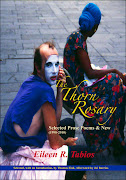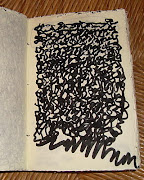Revooooo by jim mccrary:
The Awakening by Eileen Taboos [sic] is a joy. But first, here is a tale. One of my earliest childhood memories is that of being lifted up onto my father’s shoulders on a crowded street in downtown Chicago in order to “see” General MacArthur pass by in a motorcade. To my father this guy was a big hero who had been badly mistreated in some way by some in power. So….I got the cover image on Eileen’s book because I had seen the original image of MacArthur returning to the Philippines growing in a Chicago suburb in the 1950’s.. Again and again. But don’t ask me the details because I am not much for history and have no idea what the beef was between whoever or what “post liberation” affect was felt on the country being “liberated”. Here is the deal for me, just me. If I had to depend on my knowledge of history to read poetry I would be screwed….ignorant and illiterate. Maybe I am. But that does not, in anyway, lesson the wicked pleasure I receive from reading E. Tabios’s poetry. It just flat knocks me out. Then I wake up and wonder….what was that? And why does my gut hurt…oh right…I was laughing so hard. Or not. And I do know that there is more in all of this, right down thru every line and word and sub-text. I know that this is not just a crazy lady on a big mountain fiddling around with words (isn’t it?)
What ‘gets’ me about her writing is just that bit of getting a reader like me into something as funny as “a séance with William Carlos Williams…” (the first of four sections in this book) knowing also that the twist and turn of the work as it unfolds will sometimes become upended until that poem crashes and bashes through some astounded stuff, some erotic stuff, some his (herstoric) (hersteric) stuff and finally, for me, seems like relief or just plain losing it…the poem ends with a manic repetition of the word “periwinkle”…and why not. Jeez.
The second section titled: 9/11 my forty second birthday…” freaks me out because I was born on 9/10/ummm whatever. So we share, sorta that deal of being conflicted with celebrating a birthday and an ugly day in modern history. It was something to remember that coincident. And Eileen does remember that day in her way…which is usually unique and unabashed simple recording the emails she sent and received across the hours and days following events in NYC. Too me the reading is a window into how a group of loved one and friends “reads” events unfolding before them…the grace and pain and, as ever with Tabios, the poetics of all life surrounding her. What it always comes back too…and for us, the reader, her ability to describe events thru something as un-poetic as email.
The third section of the book is: “The Awakening Of A.” This, again, finds Tabios in her groove and I suddenly feel silly using that phrase before speaking about this poem. But I don’t know how else to do it and apologize if it is desensitive. For this poem, like the previous, is death too. The camps is where it comes from….and you know what that is. A camp….today….Syria, Palestine, Afghanistan, Thailand, Semolina and on and on. Past and present. Here too. Back then. Again, Tabios chooses her way and this time it is HER way, her invention of form called hay (na) ku which is a mini three stanza 6 word ….well…poetics. The striking part of this text is how such simplistic form can carry and relate such incredible weight of experience for one to “visit” and “move among” the people (women) in the camps. To focus on, as instance, menstruation…as image as example as experience…..how such basis can be imagined in some un imaginable environments. Only, and I say this knowing it is meaningless, a poet of otherworldly talents could do what has been done here. I bow in tears falling. Ms. Tabios might disagree somewhat and that’s okay with me………….I know…I know.
This book ends with a prose excerpt from "Babylon [sic] Poetics," a talk Tabios gave as part of a panel in San Francisco about the “avant garde”. I am happy that Tabios and Mr. Tills agreed to include this in the publication called The Awakening. It is a swell passage and explains in her words and feelings what it is she is doing with her poetics. Nicely done it is too. Sorry I missed that panel discussion at Small Press Traffic in San Francisco. But here is a bit of it to close up a really great book. You should track it down….trap it.
Thanks jimbo! And now I'm pleased to share a photo of jim's cat Iris who apparently likes to sleep and purr on moi book! THE AWAKENING, by the way, is available on Amazon or through the publisher theenk books.







